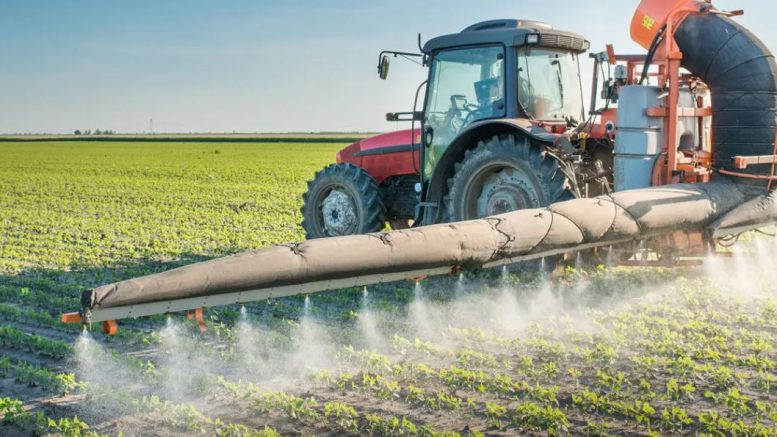75% of Phytosanitary Products Imported by Uruguay Are Chinese
Jorge Tame Jr. is the new commercial director at Stoller. (Stoller do Brasil)
Researchers from the Agricultural Research and Rural Extension Corporation of Santa Catarina (Epagri) are advancing the development of a biopesticide to control the grain stink bug (Oebalus poecilus) in irrigated rice farms in the State of Santa Catarina. The microorganism Beauveria spp. showed potential to reduce costs, improve grain quality, and reduce the risk of water and soil contamination. (Epagri)
The IAC Sugarcane Program, of the Agronomic Institute of Campinas, conducted experiments with biological nematicides and insecticides on sugarcane farms. Among the results, the effectiveness of microorganisms with relatively new uses in sugarcane farming stands out, such as the Cordyceps fungus for controlling sugarcane leafhoppers and the Tetrastichus microwasp for controlling the sugarcane borer. “Regarding the results of these newer technologies, overall, the reductions in borer populations were significant, with infestation intensity rates falling to less than half of the untreated area”. (IAC)
The Fertilizer Purchasing Power Index for July closed at 1.32, up 4.6% from the previous month. This change was driven by an unstable global environment, marked by falling commodity prices and rising fertilizer prices. (The Mosaic Company)
The National Fertilizer Distribution Association reveals that, from January to May of 2025, fertilizer deliveries to the Brazilian market totaled 15.83 million tonnes, an increase of 11.4% compared to the same period in 2024. In May alone, 3.70 million tonnes were delivered, representing a 13.8% increase compared to the same month of the previous year. State of Mato Grosso led deliveries in the period, accounting for 24% of the total. (ANDA)
Mosaic reported net income of US$ 411 million and diluted earnings per share of US$ 1.29 for the second quarter of 2025. Adjusted EBITDA was US$ 566 million. “The work we accomplished in the first half paves the way for a stronger second half of the year, driven by operational improvements, reduced plant shutdowns, excellent performance in Brazil, and favorable fertilizer market fundamentals”, said CEO Bruce Bodine. Mosaic also completed its US$ 150 million cost reduction program initiated two years ago, with $106 million saved in the Brazilian segment and US$ 55 million in SG&A. (The Mosaic Company)
ICL released financial results for the second quarter of 2025, ended June 30. Consolidated sales totaled US$1.8 billion, approximately US$80 million higher than the previous year. Operating profit was US$181 million, compared to US$211 million in the second quarter of 2024, with adjusted operating profit of US$201 million, compared to US$225 million in the same period. In Brazil, higher prices offset the decline in volumes, although exchange rate fluctuations affected gross margin. (ICL Group)
Plant Health Care expects a 90% expansion by 2025 and aims to quadruple its market share in Brazil over the next five years, reaching a cumulative volume of US$ 60 million. (PHC)
A meeting at the headquarters of the Agronomic Institute’s Engineering and Automation Center in Jundiaí, São Paulo, brought together organizations and experts from various fields to advance the development of effective strategies for controlling grape ripe rot. The fungal disease affects growing areas in Rio Grande do Sul and also the so-called Fruit Circuit in the Jundiaí region, raising concerns among farmers and researchers about potential losses. According to scientific researcher Hamilton Ramos, director of CEA-IAC, an agency within the São Paulo State Department of Agriculture and Supply, the meeting at the research center brought together representatives from the Jundiaí city government and the local Agricultural Association, as well as grape farmers and the São Paulo State Biological Institute. “So far, we’ve observed that the fungal variants affecting Jundiaí are different from those identified in Rio Grande do Sul,” Ramos said. (IAC)
Paulo Tibúrcio, executive president of the National Association of Agricultural and Veterinary Input Distributors, said on Tuesday (August 5th) that cases of bankruptcy protection (similar to US’ Chapter 11) and extrajudicial recovery of input distributors are mainly due to governance failures and do not represent a widespread crisis in the input distribution sector. (Andav)
Between July 28th and August 1st, the Paraná Agricultural Defense Agency conducted Operation Agro+ in municipalities bordering Marialva, a city in the Northwest region of the State of Paraná, recognized as the largest grape farmer. The operation’s objective is to promote the appropriate application of pesticides, prioritizing efficient pest and disease control while simultaneously reducing drift, a phenomenon that can damage sensitive crops and the environment. (Adapar)
Brazilian coffee production generated US$493 million in crop protection products in the 2024/25 season. This result is primarily due to a significant 20% increase in the intensity of crop protection treatments. The amount recorded during the period was not more robust due to the 10% decline in crop protection product prices and costs, in reais, and the negative exchange rate impact, also in the range of 10%. On the other hand, the potential treated area reached 35.2 million hectares. “This growth in technology adoption reflects scenarios of pressure from pests, fungal diseases, and nematodes, as well as the demand for herbicides in the face of the incidence of invasive plants,” emphasizes Cristiano Limberger, a research specialist at Kynetec. “There was a marked increase in key coffee pests and diseases, such as coffee berry borer, rust, cercospora, and the invasive plants trapoeraba, buva, goosefoot grass, and morning glory”. (Kynetec Brasil)
FMC is investing more than US$ 9.19 million in Brazil this year to expand its presence in the field. The funds have been mainly used for hiring specialized teams. (FMC Corporation)
The Central-West region of the State Paraná reveals significant potential for the pesticide market, particularly for the 2025/26 summer and 2025/26 winter crop harvests. A survey by EEmovel Agro indicates that, to date, between 30% and 35% of pesticides intended for the summer crop have already been sold, while for the second-crop, sales reach only 5% to 10%. Historically, this average typically exceeds 80% for this period. (EEmovel Agro)
Agricultural input distribution market in Brazil recorded revenues of US$ 30.70 billion in 2024, according to data from the 10th National Distribution Survey, conducted by the National Association of Agricultural and Veterinary Input Distributors in partnership with the Center for Advanced Studies on Applied Economics. (Andav; Cepea)
8 pesticide registration requests were withdrawn in response to the registrants’ requests. (Official Gazette, Act No. 31, dated 08/01/2025, MAPA)
In compliance with the court decision, Anvisa approves the toxicological evaluation of abamectin by Tecnomyl. (DOU, Resolution No. 3015 of 08/07/2025, Anvisa)
Cemvita signed an agreement to install the world’s first industrial plant for biofertilizers through bioconversion in the State of Rio Grande do Sul. The project integrates agriculture and renewable energy, has technical support and incentives from Invest RS, and reinforces the commitment to a low-carbon economy in the region. (Cemvita; Invest RS)

Latin America
Acadian Plant Health announced the expansion of its coverage from South America to all of Latin America, offering biostimulation technologies based on Ascophyllum nodosum algae in partnership with Koppert and as raw material for other companies. (Acadian Plant Health)
Corteva reported a 43% increase in net income, with US$ 2.05 billion in the first half of 2025, revenue of US$ 10.87 billion, and growth in sales of seeds and new crop protection products. Adjusted Ebitda rose 14% to US$ 3.35 billion, and the company forecasts annual revenue of up to US$ 17.8 billion and a favorable outlook for Latin America in the second half of the year. (Corteva)
Bioinputs market in Argentina, valued at US$ 124 million and covering 18.6 million hectares, is growing at a rate of 14% per year, compared to 5% for chemicals, and represents 4% of the sector, with emphasis on seed treatment with Bradyrhizobium. The Argentine government has simplified the approval of genetically modified microorganisms, renewed the Advisory Committee on Bioinputs for Agricultural Use, and has already granted 55 “Argentine Bioproducts” seals, 40% of them during this administration, in addition to seeking regulatory harmonization in Mercosur. (Casafe)
In Argentina‘s Patagonia, olive farmers have managed to cultivate olive trees that can withstand frosts of up to -14°C by using biostimulants based on Macrocystis pyrifera seaweed. (Biotec SA; University of Buenos Aires)
Researchers from the National University of Tierra del Fuego and Argentina‘s National Scientific and Technical Research Council have developed Tricho DF, a bioinput containing local strains of Trichoderma adapted to extreme cold, which increases lettuce growth and reduces gray mold, also present in strawberries. (INTA; Conicet)
Government of Argentina has authorized the commercialization of genetically modified cotton that is resistant to lepidopteran insects and tolerant to glyphosate and glufosinate ammonium herbicides, with the aim of increasing productivity and reducing costs. (Aapresid)
Chile‘s Agricultural and Livestock Service has changed the phytosanitary status of the nematode Aphelenchoides fragariae, which causes dwarfism in strawberries, from a quarantine pest absent to a pest present in the country, reinforcing the requirement for control in registered nurseries to prevent the sale of contaminated plants. (SAG)
Since June 30th, Mexico‘s National Health and Agrifood Quality Service has been working in municipalities to control locusts, offering training and technical assistance to protect essential crops such as corn and beans. The Phytosanitary Management Project has allocated approximately US$ 27,000 for inputs and reinforcement of actions, aiming to contain the pest and minimize economic and productivity impacts. (Senasica)
Ministry of Agriculture of Uruguay confirmed the presence of glyphosate in the courtyard of the Guichón Agricultural School after spraying in a neighboring field, which was not registered in the Single Register of Operators. There was drift of the herbicide, violating a decree that prohibits exposure, causing symptoms in students. (MGAP)
75% of phytosanitary products imported by Uruguay are Chinese, with 1,891 active registrations, mainly herbicides. Uruguayan imports total US$ 196.4 million annually, and the country is advancing in the regulation and use of bioinputs, signing agreements with China for safety, traceability, and innovation in the sector. (Ccpia)

READ MORE:

